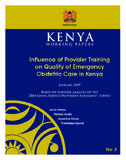Influence of provider training on quality of emergency obstetric care in Kenya

View/
Date
2009Author
Olenja, Joyce
Godia, Pamela
Kibaru, Josephine
Egondi, Thaddaeus
Language
enMetadata
Show full item recordAbstract
In addition to infectious diseases, maternal and neonatal conditions account for a substantial part
of the health gap between rich and poor countries. For example, more than 99 percent of
maternal deaths occur in the developing world. The majority of the deaths are caused by direct
obstetric complications, including haemorrhage, sepsis, eclampsia, obstructed labour, and unsafe
abortion practices. In Kenya, complications related to pregnancy and childbirth are leading
causes of morbidity and mortality, translating to 414 maternal deaths per 100,000 live births.
Although 88 percent of Kenyan women attend antenatal care, only 40 percent deliver in the
health facilities, and only 42 percent of all deliveries have skilled attendance at delivery. In the
Kenyan context, access to and use of quality emergency obstetric care (EmOC) are essential to
efforts aimed at reducing maternal morbidity and mortality.
We examine data from the 2004 Kenya Service Provision Assessment (KSPA) to assess
the availability of EmOC services in Kenya, and to demonstrate the importance of health worker
training in the delivery of these life-saving services. We find that less than 20 percent of
maternal health workers interviewed had received training in focused antenatal or postnatal care
in the last three years. Among caregivers providing delivery services, only 18 percent had
received training in lifesaving skills, and only 37 percent had received training in the prevention
of mother-
to
-child transmission of HIV during the last three years. Our analysis also
demonstrates that training is a critical element in the detection and management of
complications. Recent training in relevant subject matter was found to be significantly and
positively associated with the ability to provide quality care in the event of unsafe abortion and
postpartum haemorrhage. Training was also positively associated with the ability to provide
appropriate care in the event of a retained placenta.
Publisher
University of Nairobi
Collections
- School of Medicine [15]
